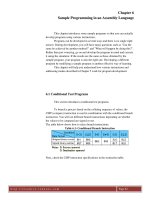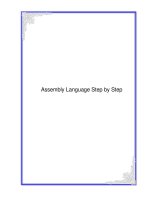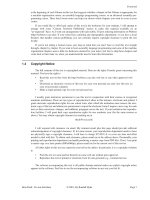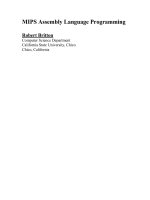Assembly language progdoc
Bạn đang xem bản rút gọn của tài liệu. Xem và tải ngay bản đầy đủ của tài liệu tại đây (831.17 KB, 244 trang )
Part Number 02-00036-005
October 1992
Your comments on our products and publications
are welcome. A postage-paid form is provided for
this purpose on the last page of this manual.
MIPS
Assembly Language
Programmer’s Guide
ASM-01-DOC
Copyright
1989-1992 Silicon Graphics, Inc. All Rights Reserved.
This manual documents MIPS Pascal version 3.10.
RISComputer, RISCwindows, and RISC/os are trademarks of Silicon Graphics,, Inc.
UNIX is a Trademark of UNIX System Laboratories, Inc.
Silicon Graphics, Inc.
2011 North Shoreline Blvd.
Mountain View, CA 94039-7311
Customer Service
U.S. and Canada: 1 (800) 800-4SGI
International: Contact your local sales representative
Assembly Language Programmer’s Guide iii
Preface: About This Book
This book describes the assembly language supported by the RISCompiler
system, its syntax rules, and how to write assembly programs. For
information on assembling and linking an assembly language program, see
the MIPS RISCompiler and C Programmer’s Guide.
The assembler converts assembly language statements into machine code. In
most assembly languages, each instruction corresponds to a single machine
instruction; however, some assembly language instructions can generate
several machine instructions. This feature results in assembly programs that
can run without modification on future machines, which might have different
machine instructions.
See Appendix B for more information about assembler instructions that
generate multiple machine instructions.
Audience
This book assumes that you are an experienced assembly language
programmer. The assembler produces object modules from the assembly
instructions that the C, Fortran 77, and Pascal compilers generate. It therefore
lacks many functions normally present in assemblers. You should use the
assembler only when you need to:
• Maximize the efficiency of a routine, which might not be possible in
C, Fortran 77, Pascal, or another high-level language; for example, to
write low-level I/O drivers.
• Access machine functions unavailable in high-level languages or
satisfy special constraints such as restricted register usage.
• Change the operating system.
• Change the compiler system.
Further system information can be obtained from the manuals listed at the end
of this section.
About This Book
iv Assembly Language Programmer’s Guide
Topics Covered
This book has these chapters:
• Chapter 1: Registers describes the format for the general registers,
the special registers, and the floating point registers.
• Chapter 2: Addressing describes how addressing works.
• Chapter 3: Exceptions describes exceptions you might encounter
with assembly programs.
• Chapter 4: Lexical Conventions describes the lexical conventions
that the assembler follows.
• Chapter 5: Instruction Set describes the main processor’s
instruction set, including notation, load and store instructions,
computational instructions, and jump and branch instructions.
• Chapter 6: Coprocessor Instruction Set describes the coprocessor
instruction sets.
• Chapter 7: Linkage Conventions describes linkage conventions for
all supported high-level languages. It also discusses memory
allocation and register use.
• Chapter 8: Pseudo-Op-Codes describes the assembler’s pseudo-
operations (directives).
• Chapter 9: MIPSObject File Format provides an overview of the
components comprising the object file and describes the headers and
sections of the object file.
• Chapter 10: Symbol Table describes the purpose of the Symbol
Table and the format of entries in the table. This chapter also lists the
symbol table routines that are supplied.
• Chapter 11: Execution and Linking Format describes Execution
and Linking Format (ELF) for object files. This chapter also
describes the components of an elf object file, symbol table format,
global data area, register information, and relocation.
• Chapter 12: Program Loading and Dynamic Linking describes the
object file structures that relate to program execution. This chapter
also describes how the process image is created from executable files
and object files.
• Appendix A: Instruction Summary summarizes all assembler
instructions.
• Appendix B: Basic Machine Definition describes instructions that
generate more than one machine instruction.
• Index. Contains index entries for this publication.
About This Book
Assembly Language Programmer’s Guide v
Special Text Notations
Several special notations are used throughout this manual to differentiate
among the following types of information:
Note
❋
A note presents information of greater-than-normal importance.
Detail
☞
Printed in a
sans serif
font, a
detail
presents additional information
that is of ancillary importance.
For More Information
As you use this manual, consult the following book(s):
• RISCompiler and C Programmer’s Guide
(Order number CMP-01-DOC)
• MIPS RISC Architecture
(Order number SYS-02-DOC)
• MIPS RISC/os Programmer’s Reference Manual
(ROS-01-DOC)
• MIPS RISC/os User’s Reference Manual
(ROS-02-DOC)
About This Book
vi Assembly Language Programmer’s Guide
Assembly Language Programmer’s Guide vii
Contents
Preface: About This Book
Audience iii
Topics Covered iv
Special Text Notations v
For More Information v
1
Registers
Register Format 1-1
Special Registers 1-5
2
Addressing
Address Formats 2-2
Address Descriptions 2-3
3
Exceptions
Main Processor Exceptions 3-1
Floating-Point Exceptions 3-2
4
Lexical Conventions
Tokens 4-1
Comments 4-2
Identifiers 4-2
Constants 4-2
Scalar Constants 4-3
Floating Point Constants 4-3
String Constants 4-4
viii Assembly Language Programmer’s Guide
Multiple Lines Per Physical Line 4-5
Statements 4-6
Label Definitions 4-6
Null Statements 4-7
Keyword Statements 4-7
Expressions 4-7
Precedence 4-7
Expression Operators 4-8
Data Types 4-8
Type Propagation in Expressions 4-10
5
Instruction Set
Instruction Classes 5-1
Reorganization Constraints and Rules 5-2
Instruction Notation 5-2
Load and Store Instructions 5-3
Load and Store Formats 5-3
Load Instruction Descriptions 5-4
Store Instruction Descriptions 5-7
Computational Instructions 5-10
Computational Formats 5-10
Computational Instruction Descriptions 5-13
Jump and Branch Instructions 5-21
Jump and Branch Formats 5-21
Jump and Branch Instruction Descriptions 5-23
Special Instructions 5-25
Special Formats 5-25
Special Instruction Descriptions 5-26
Coprocessor Interface Instructions 5-27
Coprocessor Interface Formats 5-27
Coprocessor Interface Instruction Descriptions 5-28
6
Coprocessor Instruction Set
Instruction Notation 6-1
Floating-Point Instructions 6-2
Floating-Point Formats 6-3
Floating-Point Load and Store Formats 6-3
Assembly Language Programmer’s Guide ix
Floating-Point Load and Store Descriptions 6-4
Floating-Point Computational Formats 6-4
Floating-Point Computational Instruction Descriptions 6-7
Floating-Point Relational Operations 6-8
Floating-Point Relational Instruction Formats 6-10
Floating-Point Relational Instruction Descriptions 6-11
Floating-Point Move Formats 6-13
Floating-Point Move Instruction Descriptions 6-13
System Control Coprocessor Instructions 6-13
System Control Coprocessor Instruction Formats 6-13
System Control Coprocessor Instruction Descriptions 6-14
Control and Status Register 6-15
Floating-Point Rounding 6-20
7
Linkage Conventions
Introduction 7-1
Program Design 7-2
Register Use and Linkage 7-2
The Stack Frame 7-3
The Shape of Data 7-7
Examples 7-7
Learning by Doing 7-11
Calling a High-Level Language Routine 7-11
Calling an Assembly Language Routine 7-13
Memory Allocation 7-15
8
Pseudo Op-Codes
9
MIPS Object File Format
Overview 9-2
The File Header 9-4
File Header Magic Field (f_magic) 9-5
Flags (f_flags) 9-5
Optional Header 9-7
Optional Header Magic Field (magic) 9-8
Section Headers 9-8
x Assembly Language Programmer’s Guide
Section Name (s_name) 9-9
Flags (s_flags) 9-10
Global Pointer Tables 9-11
Shared Library Information 9-12
Section Data 9-12
Section Relocation Information 9-15
Relocation Table Entry 9-15
Assembler and Link Editor Processing 9-16
Object Files 9-22
Impure Format (OMAGIC) Files 9-23
Shared Text (NMAGIC) Files 9-24
Demand Paged (ZMAGIC) Files 9-25
Target Shared Library (LIBMAGIC) Files 9-28
Objects Using Shared Libraries 9-28
Ucode objects 9-29
Loading Object Files 9-29
Archive files 9-30
Link Editor Defined Symbols 9-31
Runtime Procedure Table Symbols 9-32
10
Symbol Table
Overview 10-2
Format of Symbol Table Entries 10-8
Symbolic Header 10-8
Line Numbers 10-9
Procedure Descriptor Table 10-13
Local Symbols 10-13
Optimization Symbols 10-17
Auxiliary Symbols 10-17
File Descriptor Table 10-20
External Symbols 10-21
11
Execution and Linking Format
Object File Format 11-2
ELF Header 11-3
Sections 11-7
Section Header Table 11-7
Assembly Language Programmer’s Guide xi
Section Header 11-8
Special Sections 11-14
String Tables 11-18
ELF Symbol Table 11-18
Symbol Type 11-21
Symbol Values 11-22
Global Data Area 11-23
Register Information 11-25
Relocation 11-26
12
Program Loading and Dynamic Linking
Program Header 12-2
Base Address 12-4
Segment Permissions 12-4
Segment Contents 12-5
Program Loading 12-6
Dynamic Linking 12-9
Program Interpreter 12-9
Dynamic Linker 12-9
Dynamic Section 12-11
Shared Object Dependencies 12-18
Global Offset Table (GOT) 12-19
Calling Position Independent Functions 12-20
Symbols 12-22
Relocations 12-22
Hash table 12-23
Initialization and Termination Functions 12-23
Quickstart 12-24
Shared Object List 12-24
Conflict Section 12-26
Ordering 12-26
A
Instruction Summary
xii Assembly Language Programmer’s Guide
B
Basic Machine Definition
Load and Store Instructions B-1
Computational Instructions B-2
Branch Instructions B-3
Coprocessor Instructions B-3
Special Instructions B-3
Index
Assembly Language Programmer’s Guide xiii
Figures
Figure 1-1: Big-endian Byte Ordering 1-2
Figure 1-2: Little-endian Byte Ordering 1-2
Figure 4-1: Section and location counters 4-5
Figure 6-1: Floating-point Formats 6-3
Figure 6-2: Floating Control and Status Register 31 6-15
Figure 7-1: Stack Organization 7-4
Figure 7-2: Stack Example 7-5
Figure 7-3: Non-Leaf Procedure 7-8
Figure 7-4: Leaf Procedure Without Stack Space for
Local Variables 7-9
Figure 7-5: Leaf Procedure With Stack Space for
Local Variables 7-10
Figure 7-6: Layout of memory (User Program View) 7-16
Figure 9-1: Object File Format 9-3
Figure 9-2: Organization of Section Data 9-13
Figure 9-3: Relocation Table Entry for Undefined
External Symbols 9-17
Figure 9-4: Relocation Table Entry for a Local
Relocation Entry 9-18
Figure 9-5: Layout of OMAGIC Files in Virtual Memory 9-23
Figure 9-6: Layout of NMAGIC Files in Virtual Memory 9-24
Figure 9-7: Layout of ZMAGIC Files in Virtual Memory 9-26
Figure 9-8: Layout of a ZMAGIC File on Disk 9-27
Figure 10-1: The Symbol Table - Overview 10-2
Figure 10-2: Functional Overview of the Symbolic Header 10-4
Figure 10-3: Logical Relationship between the File
Descriptor Table and Local Symbols 10-5
Figure 10-4: Physical Relationship of a File Descriptor
Entry to Other Tables 10-6
Figure 10-5: Logical Relationship between the File
Descriptor Table and Other Tables 10-7
Figure 10-6: Source Listing for Line Number Example 10-11
Figure 10-7: Source Listing for Line Number Example 10-12
Figure 12-1: Example Executable File 12-7
xiv Assembly Language Programmer’s Guide
Assembly Language Programmer’s Guide xv
Tables
Table 1-1: General (Integer) Registers 1-4
Table 1-2: Special Registers 1-5
Table 1-3: Floating-Point Registers 1-6
Table 2-1: Address Formats 2-2
Table 2-2: Assembler Addresses 2-3
Table 4-1: Backslash Conventions 4-4
Table 4-2: Expression Operators 4-8
Table 4-3: Data Types 4-9
Table 5-1: Load and Store Formats 5-3
Table 5-2: Load and Store Formats for mips3
Architecture Only 5-4
Table 5-3: Load Instruction Descriptions 5-4
Table 5-4: Load Instruction Descriptions for mips3
Architecture Only 5-6
Table 5-5: Store Instruction Descriptions 5-7
Table 5-6: Store Instruction Descriptions for mips3
Architecture Only 5-9
Table 5-7: Computational Instruction Formats 5-10
Table 5-8: Computational Instruction Formats for mips3 Architecture
Only 5-12
Table 5-9: Computational Instruction Descriptions 5-13
Table 5-10: Computational Instruction Descriptions for
mips3 Architecture Only 5-18
Table 5-11: Jump and Branch Instruction Formats 5-21
Table 5-12: Jump and Branch Instruction Descriptions 5-23
Table 5-13: Special Instruction Formats 5-25
Table 5-14: Special Instruction Descriptions 5-26
Table 5-15: Coprocessor Interface Instruction Formats 5-27
Table 5-16: Coprocessor Interface Instruction Descriptions 5-28
Table 6-1: Floating-Point Load and Store Formats 6-3
Table 6-2: Floating-Point Load and Store Descriptions 6-4
Table 6-3: Floating-Point Computational Instruction
Formats 6-4
xvi Assembly Language Programmer’s Guide
Table 6-4: Floating-Point Computational Instruction
Formats for mips3 Architecture Only 6-6
Table 6-5: Floating-Point Computational Instruction
Descriptions 6-7
Table 6-6: Floating-Point Relational Operators 6-8
Table 6-7: Floating-Point Relational Instruction Formats 6-10
Table 6-8: Floating-Point Relational Instruction
Descriptions 6-11
Table 6-9: Floating-Point Move Instruction Formats 6-13
Table 6-10: Floating-Point Move Instruction Descriptions 6-13
Table 6-11: System Control Instruction Formats 6-13
Table 6-12: System Control Coprocessor Instruction
Descriptions 6-14
Table 7-1: Floating-Point Registers 7-2
Table 8-1: Pseudo Op-Codes 8-1
Table 9-1: File Header Format 9-4
Table 9-2: File Header Magic Numbers 9-5
Table 9-3: File Header Flags 9-6
Table 9-4: Optional Header Definition 9-7
Table 9-5: RISC/os Magic Numbers 9-8
Table 9-6: Section Header Format 9-8
Table 9-7: Section Header Constants for Section Names 9-9
Table 9-8: Format of s_flags Section Header Entry 9-10
Table 9-9: Format of a Relocation Table Entry 9-15
Table 9-10: Section Numbers for Local Relocation Entries 9-15
Table 9-11: Relocation Types 9-16
Table 9-12: Link Editor Defined Symbols 9-31
Table 10-1: Format of the Symbolic Header 10-8
Table 10-2: Format of a Line Number Entry 10-9
Table 10-3: Source Listing for Line Number Example 10-11
Table 10-4: Format of a Procedure Descriptor Table Entry 10-13
Table 10-5: Format of a Local Symbols Entry 10-13
Table 10-6: Index and Value as a Function of Symbol
Type and Storage Class 10-14
Table 10-7: Symbol Type (st) Constants Supported by
the Compiler 10-16
Table 10-8: Storage Class Constants Supported by
the Compiler 10-16
Table 10-9: Storage Class Constants Supported by
the Compiler 10-17
Table 10-10: Format of an Type Information Record Entry 10-18
Assembly Language Programmer’s Guide xvii
Table 10-11: Basic Type (bt) Constants 10-19
Table 10-12: Type Qualifier (tq) Constants 10-19
Table 10-13: Format of File Descriptor Entry 10-20
Table 10-14: Format an Entry in External Symbols 10-21
Table 11-1: sh_link and sh_info values 11-13
Table 11-2: Special Sections 11-14
Table 11-3: Relocation Calculations 11-28
Table 12-1: p_flags Values and Interpretation 12-5
Table 12-2: Text and Data Segments 12-7
Table 12-3: Example Shared Object Segment Addresses 12-8
Table 12-4: Dynamic Arrays Tags d_tag 12-15
Table A-1: Main Processor Instruction Summary A-2
Table A-2: System Coprocessor Instruction Summary A-6
Table A-3: Floating Point Instruction Summary A-6
xviii Assembly Language Programmer’s Guide
Assembly Language Programmer’s Guide 1-1
Chapter 1
Registers
1
This chapter describes the organization of data in memory, and the naming
and usage conventions that the assembler applies to the CPU and FPU
registers. See Chapter 7 for information regarding register use and linkage.
Register Format
The CPU’s byte ordering scheme (or endian issues) affects memory
organization and defines the relationship between address and byte position
of data in memory.
The byte ordering is configurable (configuration occurs during hardware
reset) into either big-endian or little-endian byte ordering. When configured
as a big-endian system, byte 0 is always the most-significant (leftmost) byte.
When configured as a little-endian system, byte 0 is always the least-
significant (rightmost byte).
Figure 1-1 and Figure 1-2 illustrate the ordering of bytes within words and the
ordering of halfwords for big and little endian systems.
Chapter 1
1-2 Assembly Language Programmer’s Guide
Chapter 1
Figure 1-1: Big-endian Byte Ordering
Figure 1-2: Little-endian Byte Ordering
byte 0 byte 1 byte 2 byte 3
sign & most-
significant bits
sign & most-
Bit:
Word
Halfword
byte 0 byte1
31 24 23 16 15 8 7 0
15 8 7 0Bit:
significant bits
byte 0byte 1byte 2byte 3
sign & most-
significant bits
Bit:
Word
Halfword
byte 0byte1
31 24
23 16 15 8
7 0
15 8 7 0Bit:
sign & most-
significant bits
Registers
Assembly Language Programmer’s Guide 1-3
Chapter 1
General Registers
The CPU has thirty-two 32-bit registers. In the mip3 architecture, the size of
each of the thirty two integer registers is 64-bit.
Table 1-1 summarizes the assembler’s usage and conventions and restrictions
for these registers. The assembler reserves all register names; you must use
lowercase for the names. All register names start with a dollar sign($).
The general registers have the names $0 $31. By including the file regdef.h
(use #include <regdef.h>) in your program, you can use software names for
some general registers. The operating system and the assembler use the
general registers $1, $26, $27, $28, and $29 for specific purposes.
NOTE: Attempts to use these general registers in other ways can produce
unexpected results.) If a program uses the names $1, $26, $27, $28, $29 rather
than the names $at, $kt0, $kt1, $gp, $sp respectively, the assembler issues
warning messages.
Chapter 1
1-4 Assembly Language Programmer’s Guide
Chapter 1
NOTE: General register $0 always contains the value 0. All other general
registers are equivalent, except that general register $31 also serves as the
implicit link register for jump and link instructions. See Chapter 7 for a
description of register assignments.
Table 1-1: General (Integer) Registers
Register
Name
Software Name
(from regdef.h)
Use and Linkage
$0 Always has the value 0.
$at Reserved for the assembler.
$2 $3 v0-v1
Used for expression evaluations and to hold the integer type
function results. Also used to pass the static link when calling
nested procedures.
$4 $7 a0-a3
Used to pass the first 4 words of integer type actual
arguments, their values are not preserved across procedure
calls.
$8 $15 t0-t7
Temporary registers used for expression evaluations; their
values aren’t preserved across procedure calls.
$16 $23 s0-s7
Saved registers. Their values must be preserved across
procedure calls.
$24 $25 t8-t9
Temporary registers used for expression evaluations; their
values aren’t preserved across procedure calls.
$26 27 or
$kt0 $kt1
k0-k1 Reserved for the operating system kernel.
$28 or $gp gp Contains the global pointer.
$29 or $sp sp Contains the stack pointer.
$30 or $fp fp
Contains the frame pointer (if needed); otherwise a saved
register (like s0-s7).
$31 ra
Contains the return address and is used for expression
evaluation.
Registers
Assembly Language Programmer’s Guide 1-5
Chapter 1
Special Registers
The CPU defines three 32-bit special registers: PC (program counter), HI and
LO, as shown in Table 1-2. The HI and LO special registers hold the results
of the multiplication (mult and multu) and division (div and divu)
instructions.
You usually do not need to refer explicitly to these special registers;
instructions that use the special registers refer to them automatically.
NOTE: In mips3 architecture, the HI and Lo registers hold 64-bits.
Table 1-2: Special Registers
Name Description
PC Program Counter
HI
Multiply/Divide special register holds the most-
significant 32 bits of multiply, remainder of divide
LO
Multiply/Divide special register holds the least-
significant 32 bits of multiply, quotient of divide
Chapter 1
1-6 Assembly Language Programmer’s Guide
Chapter 1
Floating-Point Registers
The FPU has sixteen floating-point registers. Each register can hold either a
single-precision (32 bit) or double-precision (64 bit) value. In case of a
double-precision value, $f0 holds the least-significant half, and $f1 holds the
most-significant half. All references to these registers use an even register
number (e.g., $f4). Table 1-3 summarizes the assembler’s usage conventions
and restrictions for these registers.
Table 1-3: Floating-Point Registers
Register
Name
Use and Linkage
$f0 $f2
Used to hold floating-point type function results ($f0)
and complex type function results ($f0 has the real part,
$f2 has the imaginary part. $f4 $f10 Temporary
registers, used for expression evaluation, whose values
are not preserved across procedure calls.
$f12 $f14
Used to pass the first two single or double precision
actual arguments, whose values are not preserved
across procedure calls.
$f16 $f18
Temporary registers, used for expression evaluation,
whose values are not preserved across procedure
calls.
$f20 $f30
Saved registers, whose values must be preserved
across procedure calls.
Assembly Language Programmer’s Guide 2-1
Chapter 2
Addressing
2
This chapter describes the formats that you can use to specify addresses. The
machine uses a byte addressing scheme. Access to halfwords requires
alignment on even byte boundaries, and access to words requires alignment
on byte boundaries that are divisible by four. Any attempt to address a data
item that does not have the proper alignment causes an alignment exception.
The unaligned assembler load and store instructions may generate multiple
machine language instructions. They do not raise alignment exceptions.
These instructions load and store unaligned data:
• Load word left (lwl)
• Load word right (lwr)
• Store word left (swl)
• Store word right (swr)
• Unaligned load word (ulw)
• Unaligned load halfword (ulh)
• Unaligned load halfword unsigned (ulhu)
• Unaligned store word (usw)
• Unaligned store halfword (ush)
• These instructions load and store aligned data
• Load word (lw)
• Load halfword (lh)
• Load halfword unsigned (lhu)
• Load byte (lb)









